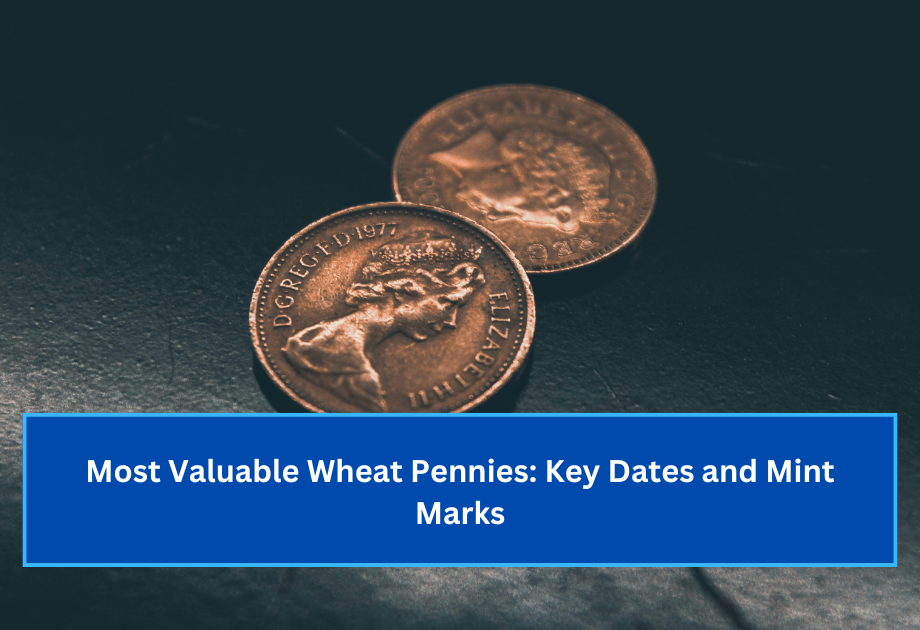Wheat pennies, also known as Lincoln wheat cents, were minted from 1909 to 1958 and have become a favorite among coin collectors. With their unique design and historical significance, some of these pennies can be worth a small fortune due to their rarity, condition, and unique minting errors. This guide will highlight the key dates and mint marks to watch for when sorting through your collection of wheat pennies.
1. 1909-S V.D.B. Wheat Penny
The 1909-S V.D.B. penny is one of the most sought-after coins in the wheat penny series. The coin was the first year the Lincoln wheat cent was produced, designed by Victor David Brenner, whose initials (V.D.B.) appear at the bottom of the reverse side. However, controversy over the prominent initials led to their removal later that year, making coins with the “V.D.B.” extremely rare
2. 1914-D Wheat Penny
The 1914-D wheat penny is highly prized due to its low mintage numbers. Only about 1.2 million of these coins were produced in the Denver Mint, making it one of the scarcest and most valuable in the wheat penny series. Circulated 1914-D pennies can range from $200 to $2,000 depending on their condition. Uncirculated examples, with sharp details and minimal wear, can easily fetch over $10,000 at auction.
3. 1922 No D Wheat Penny
The 1922 No D penny is a unique error coin that was struck at the Denver Mint. Due to an issue with the dies, some of these pennies were produced without the “D” mint mark. The lack of a mint mark combined with its rarity makes it a highly valuable find for collectors. Depending on the coin’s condition, values can range from $500 for heavily worn pieces to over $20,000 for coins in pristine condition.
4. 1931-S Wheat Penny
The 1931-S penny had one of the smallest mintages among wheat cents, with only 866,000 coins struck at the San Francisco Mint. Because of its limited production, it remains one of the key dates in the series.n Circulated examples typically range from $75 to $150, while higher-grade examples can sell for $1,000 or more.
5. 1955 Double Die Wheat Penny
The 1955 Double Die penny is famous for its noticeable minting error. Due to a misalignment during the striking process, the date and lettering on the obverse of the coin appear doubled, making it easily recognizable. Prices for this coin vary based on its condition. Circulated examples typically start around $1,000, while mint-condition pieces can be valued at $15,000 to $20,000 or more.
Tips for Evaluating Your Wheat Pennies
Condition Matters
The condition, or grade, of a wheat penny plays a significant role in its value. Coins in better condition with less wear are typically more valuable. Collectors use terms like “Good,” “Fine,” and “Uncirculated” to describe a coin’s condition.
Look for Mint Marks
Mint marks can greatly affect a coin’s value. The “D” mint mark signifies the Denver Mint, while “S” indicates the San Francisco Mint. No mint mark means it was produced in Philadelphia. Key dates and mint marks like 1909-S, 1914-D, and 1931-S often command higher prices.
Check for Errors and Rare Varieties
Error coins, such as the 1955 Double Die or the 1922 No D, are highly valuable because they are unique and stand out from standard issues.
Conclusion
The value of wheat pennies goes beyond their face value due to their historical importance, key dates, and mint mark variations. If you have a collection of wheat pennies, take the time to examine them carefully. You might just discover that you have one of these rare and valuable coins in your possession. Collectors continue to seek out these treasures, and they can turn a simple penny into a lucrative investment.
FAQs
What makes a wheat penny valuable?
Rare dates, unique minting errors, and mint marks contribute to a wheat penny’s value. Coins in excellent condition are often worth significantly more.
How can I tell if I have a valuable wheat penny?
Check the date, mint mark, and condition of the penny. Look for key dates like 1909-S V.D.B., 1914-D, or coins with notable errors, such as the 1955 Double Die.
Where can I sell valuable wheat pennies?
You can sell valuable wheat pennies at coin shows, auctions, or through reputable coin dealers who specialize in rare coins.

